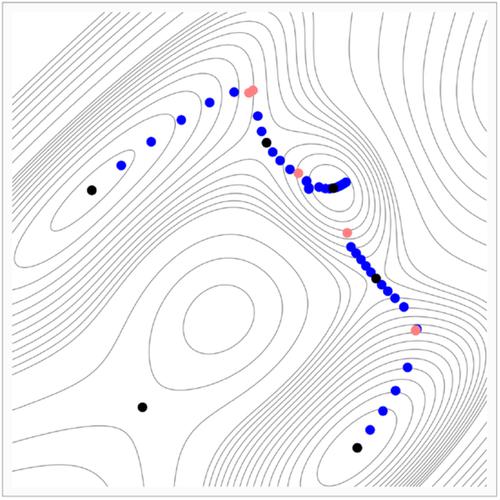当前位置:
X-MOL 学术
›
J. Comput. Chem.
›
论文详情
Our official English website, www.x-mol.net, welcomes your
feedback! (Note: you will need to create a separate account there.)
Some Mathematical Reasoning on the Artificial Force Induced Reaction Method
Journal of Computational Chemistry ( IF 3.4 ) Pub Date : 2019-12-02 , DOI: 10.1002/jcc.26115 Wolfgang Quapp 1 , Josep Maria Bofill 2
Journal of Computational Chemistry ( IF 3.4 ) Pub Date : 2019-12-02 , DOI: 10.1002/jcc.26115 Wolfgang Quapp 1 , Josep Maria Bofill 2
Affiliation

|
There are works of the Maeda–Morokuma group, which propose the artificial force induced reaction (AFIR) method (Maeda et al., J. Comput. Chem. 2014, 35, 166 and 2018, 39, 233). We study this important method from a theoretical point of view. The understanding of the proposers does not use the barrier breakdown point of the AFIR parameter, which usually is half of the reaction path between the minimum and the transition state which is searched for. Based on a comparison with the theory of Newton trajectories, we could better understand the method. It allows us to follow along some reaction pathways from minimum to saddle point, or vice versa. We discuss some well‐known two‐dimensional test surfaces where we calculate full AFIR pathways. If one has special AFIR curves at hand, one can also study the behavior of the ansatz. © 2019 The Authors. Journal of Computational Chemistry published by Wiley Periodicals, Inc.
中文翻译:

人工诱发反应法的若干数学推理
Maeda–Morokuma 小组的工作提出了人工力诱导反应 (AFIR) 方法 (Maeda et al., J. Comput. Chem. 2014, 35, 166 and 2018, 39, 233)。我们从理论的角度研究这个重要的方法。提议者的理解没有使用AFIR参数的势垒击穿点,通常是搜索到的最小值和过渡状态之间的反应路径的一半。通过与牛顿轨迹理论的比较,我们可以更好地理解该方法。它允许我们沿着一些反应路径从最小值到鞍点,反之亦然。我们讨论了一些众所周知的二维测试表面,我们在其中计算了完整的 AFIR 路径。如果手头有特殊的 AFIR 曲线,还可以研究 ansatz 的行为。© 2019 作者。
更新日期:2019-12-02
中文翻译:

人工诱发反应法的若干数学推理
Maeda–Morokuma 小组的工作提出了人工力诱导反应 (AFIR) 方法 (Maeda et al., J. Comput. Chem. 2014, 35, 166 and 2018, 39, 233)。我们从理论的角度研究这个重要的方法。提议者的理解没有使用AFIR参数的势垒击穿点,通常是搜索到的最小值和过渡状态之间的反应路径的一半。通过与牛顿轨迹理论的比较,我们可以更好地理解该方法。它允许我们沿着一些反应路径从最小值到鞍点,反之亦然。我们讨论了一些众所周知的二维测试表面,我们在其中计算了完整的 AFIR 路径。如果手头有特殊的 AFIR 曲线,还可以研究 ansatz 的行为。© 2019 作者。









































 京公网安备 11010802027423号
京公网安备 11010802027423号